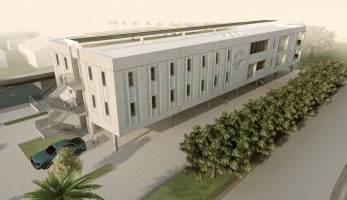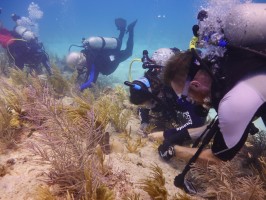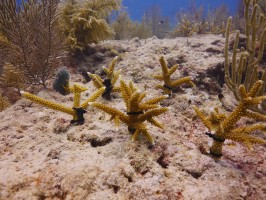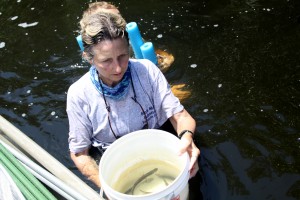Mote campaign progress: Campaign reaches $45.5 million in 2015, Keys building begins construction
2015 concluded with strong philanthropic support for Mote Marine Laboratory. By the end of the year, Mote raised $45.5 million for its Oceans of Opportunity Campaign, which invites the public to help Mote raise commitments of $50 million to achieve the vision for growth in the Lab’s 2020 Vision & Strategic Plan.
Guided by its 2020 Vision, Mote aims to advance its marine research enterprise, recruit and nurture more top scientists and educators, particularly fostering next-generation Ph.D. researchers, and expand its local and global science to support conservation and sustainable use of marine resources.
“I look back at 2015 and I am overwhelmed with gratitude,” said Dr. Michael P. Crosby, President and CEO of Mote. “The community united together to raise $45.5 million to help Mote achieve world-class science that will leave a lasting impression on our marine resources. Although we have received incredible support thus far, we are looking forward to reaching our $50 million goal, which will allow us to realistically reach our future goals outlined in our 2020 Vision & Strategic Plan.”
Oceans of Opportunity is designed to support and expand Mote’s annual research and education operations; attract and nurture the next generation of marine scientists; spur long-term growth in the endowment to provide security and sustainability for Mote’s future; protect and restore fisheries in Sarasota Bay; and finance construction of a major new Keys facility with approximately 26,000 square feet of research and science-education infrastructure.
Leadership giving
The Mote Leadership Circle, a special group of community members who understand the urgent threats facing the oceans and are each providing critical financial support of $1 million or more to the Oceans of Opportunity campaign to help address these problems.
Mote Marine Laboratory offers a special thank you to the members of the Mote Leadership Circle, including four additional donors who wish to remain anonymous and:
- Carol and Barney Barnett
- Rick and Nancy Moskovitz
- Elizabeth Moore
- James D. and Pati Ericson
- Robert and Anne Essner
- Maurice and Carolyn Cunniffe
Helping fisheries in Sarasota Bay
Sarasota philanthropists Carol and Barney Barnett donated $3 million as a part of the Campaign to help Mote implement its Fisheries Conservation and Enhancement Initiative to protect and restore fisheries in Sarasota Bay, with an expectation that others in our community will step up to provide support for to this initiative as well.
Snook are a focus of this initiative and one of the most sought after catches in Florida’s saltwater recreational fishing industry. According to the American Sportfishing Association, Florida is the top-ranked state in economic output from recreational fishing, which draws more than $8 billion to the economy annually. Saltwater fishing alone generates about 80 percent — more than $6 billion — of that income.
In 2015, Mote scientists and Florida’s Fish and Wildlife Conservation Commission (FWC) scientists placed about 400 tagged, hatchery-reared juvenile snook into Sarasota Bay as part of an ongoing research project focused on finding the most effective methods to replenish and enhance wild snook populations. That experiment was a prelude to experiments planned for summer 2016, when over 15,000 hatchery snook will be tagged and released. This research is evaluating which natural snook nursery habitats are most important in producing adult snook in Sarasota Bay to provide critical knowledge for sustaining the local snook population.
“We are very fortunate and thankful to have this Fisheries Conservation and Enhancement Initiative,” said Dr. Kenneth Leber, Associate Vice President for Mote’s Directorate for Fisheries and Aquaculture. “In the coming years, it is our goal not only to release thousands of snook into the Bay to help replenish snook when they are reduced by cold winters or red tides, but also to help our community by enabling citizens and agencies to make more informed choices about habitat protection and restoration made possible because of this Initiative.”
Mote welcomed Dr. Ryan Schloesser in September 2015, a postdoctoral scientist who, enabled by the Barnett’s donation, joined the Fisheries Ecology and Enhancement Program to help further develop and test responsible stock enhancement technology for restoring depleted snook and to advance knowledge about wild snook.
Also as part of the Initiative, scheduled for April 8-9, Mote will be hosting the William R. Mote Memorial Snook Shindig honoring Captain Scotty Moore – a catch, sample and release tournament targeting snook released by scientists from Mote’s Fisheries Ecology and Enhancement Program and our colleagues at Florida’s Fish and Wildlife Conservation Commission.
Construction Phase of Exciting Expansion in the Florida Keys Begins
Approximately $5.2 million is needed for construction of a new, state-of-the-art research and education facility based in the Florida Keys and commitments of more than $3.5 million to date have brought the project tantalizingly close to its goal.
The new building aims to advance Mote’s ability to significantly expand its research infrastructure in the Florida Keys, which is a hotbed of marine science, education and conservation that addresses the global threats facing coral reefs. The design phase of the new building is complete, and the next step is the construction phase.
The expansion will occur on Mote’s existing property on Summerland Key, which currently includes three old buildings. The new building will more than double Mote’s research and education space in the Keys, allowing the Lab to expand programs focused on studying and restoring damaged coral reefs and on finding new ways to address global threats to reefs — particularly climate change and ocean acidification.
Philanthropic donations for the new state-of-the-art LEED-certified research and education facility surpassed the $3.5 million mark in 2015 with help from three generous donations: $2 million from the Rick and Nancy Moskovitz Foundation, $1 million from Elizabeth Moore, and $325,000 from the Charles and Margery Barancik Foundation. These gifts have generated exciting momentum to start the construction process for the new building at Mote’s existing property on Summerland Key, Fla.
In early January 2016, Mote researchers emptied the current two residential and office buildings in preparation for their demolition beginning February 2016, leaving the current working lab building fully operational throughout construction. Once the new project is 99 percent complete, the old lab will be demolished.
Construction will ramp up during summer 2016, with the goal of opening the facility in early 2017. This construction process is the most visible sign that Oceans of Opportunity has entered its home stretch.
Please join us in supporting Mote’s mission — today’s research for tomorrow’s oceans — by making a donation now, during the home stretch of Oceans of Opportunity.
All gifts, no matter the amount, make a difference for our oceans and the people that depend on them.
Visit www.moteoceans.org or contact Campaign Director Erin Knievel at 941-388-4441, ext. 415, or eknievel@mote.org.




